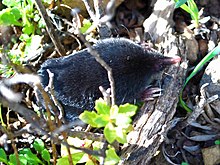Northern broad-footed mole
| Northern broad-footed mole | |
|---|---|

| |
| Scientific classification | |
| Domain: | Eukaryota |
| Kingdom: | Animalia |
| Phylum: | Chordata |
| Class: | Mammalia |
| Order: | Eulipotyphla |
| Family: | Talpidae |
| Genus: | Scapanus |
| Species: | S. latimanus
|
| Binomial name | |
| Scapanus latimanus (Bachman, 1842)
| |

| |
| Northern broad-footed mole range (includes S. occultus) | |
The northern broad-footed mole (Scapanus latimanus) is a species of mammal in the family Talpidae.[2] It is endemic to the United States, where it is found in northern California, Nevada and Oregon at elevations up to 9,800 feet (3,000 m) above sea level.[1]
Taxonomy
Formerly, this species was thought to have a wider range reaching down to northernmost Baja California, Mexico, with a disjunct population further south in Sierra de San Pedro Martir. However, taxonomic and morphological studies indicate that the subspecies in southern California and northernmost Baja California is a distinct species, the southern broad-footed mole (S. occultus) and the Sierra de San Pedro Martir subspecies is also a distinct species, the Mexican mole (S. anthonyi). Due to this, the range of S. latimanus is thought to be restricted to the United States.[3][4]
Up to 12 subspecies of S. latimanus have been recognized,[5] but S. anthonyi and S. occultus have been split as distinct species. Analysis of the remaining subspecies have found that most of them represent junior synonyms of other subspecies; under this classification, only 4 subspecies of S. latimanus remain: S. l. latimanus, S. l. minisculus, S. l. insularis, and S. l. parvus.[3]
Description
The broad-footed mole can be distinguished from other species of Scapanus by its dark brown to silvery fur which is short, soft, and plush-like in texture with uniform coloration,[6] and 40-44 unevenly spaced unicuspid teeth.[5][4] Adults bodies are short and cylindrical with a long and pointed snout. The forefeet are greatly expanded with flattened palms and long heavy claws. The tail is scantily covered with coarse hair.[6] On average, body lengths range from 5.5 to 7.1 inches (14 to 18 cm) in total length, with males slightly larger than females. Populations in more humid environments also tend to have larger individuals than those from southern, drier areas.[5] The dental formula of Scapanus latimanus is 3.1.4.33.1.4.3 × 2 = 44.[5]
Its karyotype has 2n = 34, FN = 64.[2] As with most moles, it requires moist, friable soils, where it eats earthworms, insects, other invertebrates and some plant matter.[7]
Scapanus latimanus is a fossorial mammal, living below ground for most of its life.[5] Only one animal occupies a burrow at a time and if a burrow has been vacated, it is often reoccupied within 2 days.[5] Tunnels are typically dug far below surface level and the excess earth is removed via shafts that run laterally and vertically up to the surface. The excess earth pushed out of these shafts form distinct volcano-shaped mounds with the older earth towards the outer base and the newer earth towards the core.[5] Shallow surface tunnels are sometimes dug and form a ridge in the soil on the surface. How often exactly these tunnels are used is unknown, as they are used irregularly.[5]
References
- ^ a b Matson, J.; Woodman, N.; Castro-Arellano, I. & de Grammont, P.C. (2008). "Scapanus latimanus". IUCN Red List of Threatened Species. 2008. Retrieved 9 February 2010.
- ^ a b Hutterer, R. (2005). "Order Soricomorpha". In Wilson, D.E.; Reeder, D.M (eds.). Mammal Species of the World: A Taxonomic and Geographic Reference (3rd ed.). Johns Hopkins University Press. p. 302. ISBN 978-0-8018-8221-0. OCLC 62265494.
- ^ a b Castañeda, Sergio Ticul Alvarez; Cortés-Calva, Patrica (2021-05-09). "Revision of moles in the genus Scapanus". THERYA. 12 (2): 275. doi:10.12933/therya-21-1174. ISSN 2007-3364. S2CID 236583289.
- ^ a b Yates, Terry L. & Jorge Salazar-Bravo (2004). "A Revision Of Scapanus latimanus, with the Revalidation of a Species Of Mexican Mole". In Sánchez-Cordero V. & Medellín R.A. (eds.). Contribuciones Mastozoológicas En Homenaje A Bernardo Villa (PDF). Instituto De Biología e Ins Tituto De Ecología, Unam, México. pp. 479–496.
- ^ a b c d e f g h Verts, B. J. & Leslie N. Carraway (2001). "Scapanus latimanus" (PDF). Mammalian Species. 666: 1–7. doi:10.1644/1545-1410(2001)666<0001:sl>2.0.co;2. S2CID 198968581. Archived from the original (PDF) on 2016-03-03. Retrieved 2014-02-18.
- ^ a b Grinnell, Joseph; Storer, Tracy Irwin (1924). Animal life in the Yosemite; an account of the mammals, birds, reptiles, and amphibians in a cross-section of the Sierra Nevada. Berkeley, California: University of California Press. p. 43. Retrieved 10 September 2023.
- ^ "Broad-footed Mole". Archived from the original on 2018-06-04. Retrieved 2012-08-30.
- Cite IUCN maint
- Articles with short description
- Short description matches Wikidata
- IUCN Red List least concern species
- Articles with 'species' microformats
- Articles with J9U identifiers
- Scapanus
- Endemic mammals of the United States
- Mammals described in 1842
- Taxonomy articles created by Polbot
- Taxa named by John Bachman
